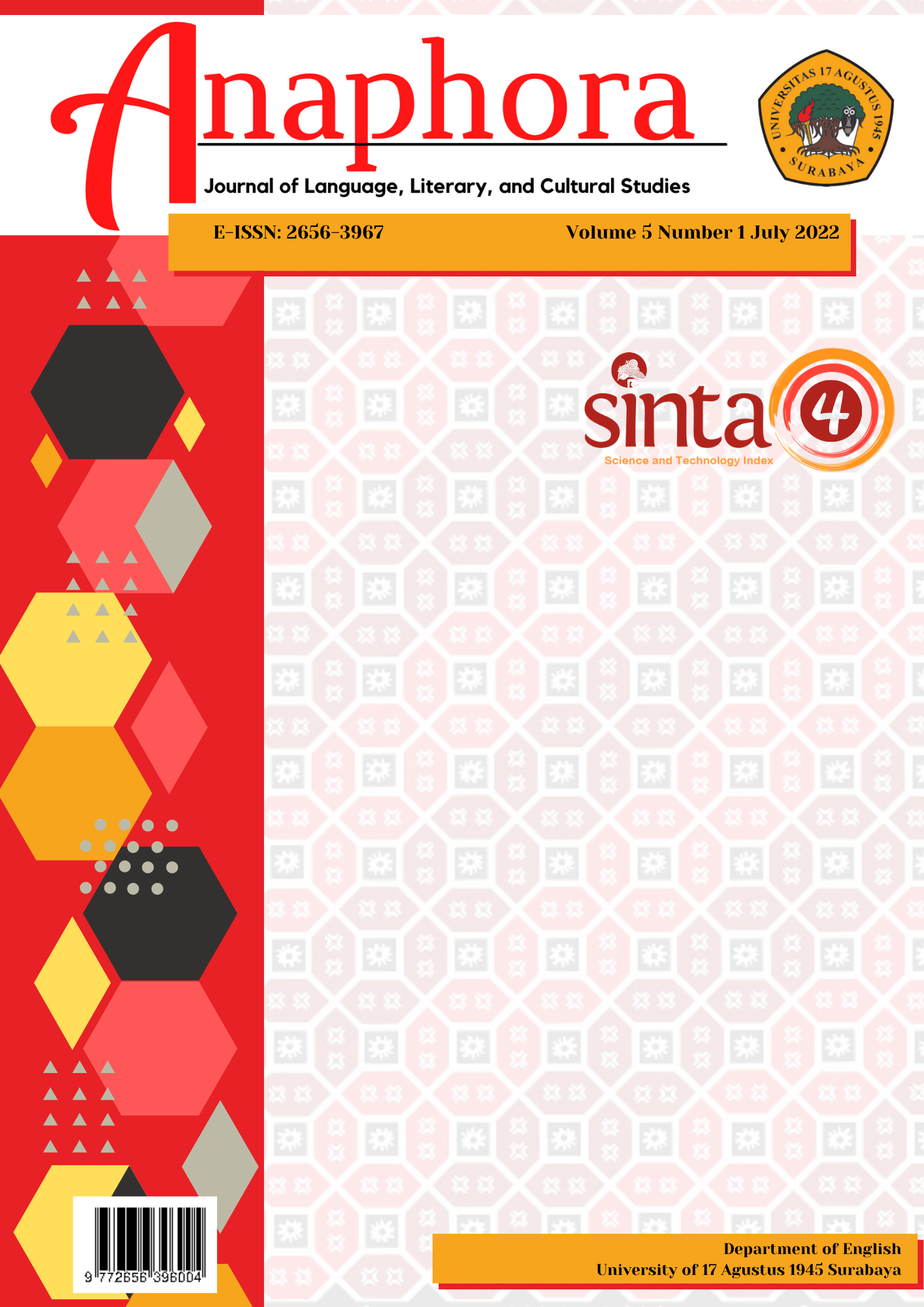Animate Metaphors to Satire Leaders in Tenas Effendy's Pantun "Kelakar"
Abstract
This writing deals with an analysis of Pantun Kelakar written by Tenas Effendy by focusing on 4 ( four) of them and analysis the animate metaphors ( animal metaphors) used in these four pantuns in exploring how those animate metaphors reflects leaders’ characters. This study is descriptive analysis where this study aims to describe the existing phenomena. In this case, this study describes the animate metaphors in Pantun Kelakar of Tenas effendy which satire leaders. The animal metaphors found in those 4 pantuns are; crocodile, monkey, lion and snake, and those animals are the analogy of leaders whose characters are associated with the characters of the animals in which they are associated with. Crocodile is the metaphor to satire leader who ignore the rules in taking or consuming something which leads to the life without guidance. The monkey is the metaphor to satire a leader who does immoral deeds. A lion is used as the metaphor of powerful leader who destroys his/her people and snake is the metaphor of sly or cunning leader. by describing those metaphors, this analysis may contribute to create awareness for leaders whose characters are reflected by the metaphors to treat this analysis as a self-reminder to change and improve the person’s character. and in the same time, this analysis may also contribute to give knowledge about some kinds of leaders with their specific characters in leading their people
Downloads
References
Chiu, H.-y., Chu, W.-L. (2019). Analysis of the Narrative Types of “Metaphor” in Animated Short Films. Art and Design Review, 7, 206–224. https://doi.org/https://doi.org/10.4236/adr.2019.74017
Effendy, T. (n.d.). Pantun Kelakar. Telindo Publishing.
Forceville, C. (2013). Metaphor and symbol: SEARCHING FOR ONE’S IDENTITY IS LOOKING FOR A HOME in animation film. Review of Cognitive Linguistics. Published under the Auspices of the Spanish Cognitive Linguistics Association, 11(2), 250–268. https://doi.org/https://doi.org/10.1075/rcl.11.2.03for
Katz-Buonincontro, J. (2018). A Review of Articles Using Observation Methods to Study Creativity in Education (1980–2018). The Journal of Creative Behavior, 54(3), 508–524. https://doi.org/https://doi.org/10.1002/jocb.385
Kiełtyka, R. (2010). Selected aspects of zoosemy: The conceptual dimension origin/social status at work. Philologia Hispalensis, 24, 167–189. https://doi.org/10.12795/PH.2010.V24.I02.03
Luanmas, M. E. (2015). Makna Metafora dan Simili Dalam Song of Solomon. JURNAL ELEKTRONIK FAKULTAS SASTRA UNIVERSITAS SAM RATULANGI, 4(2). https://ejournal.unsrat.ac.id/index.php/jefs/article/view/9942/9529
Maulina, D. E. (2012). Keanekaragman Pantun di Indonesia. Semantik, 1(1). https://doi.org/https://doi.org/10.22460/semantik.v1i1.p%25p
Sabariah, M. R. & Nadia, M. N. (2013). Animal Metaphors in Malay with Semantic Derogation. Pertanika J. Soc. Sci. & Hum, 21, 71–86.
Adilah, M. K., Mukhlisa, S., Jamal, M. (2021). Feline characteristics in English and Malay feline proverbs: a conceptual metaphor approach. Journal of Creative Practices in Language Learning and Teaching (CPLT), 9(1), 84–106. https://ir.uitm.edu.my/id/eprint/50974/1/50974.pdf
Moleong, L. J. (2018). Metodologi Penelitian Kualitatif (Edisi revi). Remaja Rosdakarya.
Murti, F. N. (2017). Jejak Pesona Pantun Dunia (Suatu Tinjauan Duiakronik-Komparatif). Seminar Nasional #3: Sastra Dan Bahasa Indonesia Dalam Konteks Global. https://jurnal.unej.ac.id/index.php/fkip-epro/article/view/4427
Ningsi, P. H. (2018). Metafora yang Menggunakan Nama-nama Binatang dalam Bahasa Minagkabau. Salingka: Majalah Ilmuah Bahasan Dan Sastra, 15(2), 111–121. https://doi.org/https://doi.org/10.26499/salingka.v15i2.210
Ningsih, S. A. (2018). Penggunaan Istilah Binatang Dalam Metafora Bahasa Indonesia Dan Bahasa Inggris. Arkhais - Jurnal Ilmu Bahasa Dan Sastra Indonesia, 9(1). https://garuda.kemdikbud.go.id/documents/detail/962167
Pasetha, A., Farajallah, D P., Gholib. (2019). Perilaku Harian Monyet Hitam Sulawesi (Macaca nigra) pada Masa Kebuntingan di Cagar Alam Tangkoko-Batuangus, Sulawesi Utara : Behavior of Crested Macaque ( Macaca nigra ) During Pregnancy at Tangkoko-Batuangus Nature Reserve, North Sulawesi. Jurnal Sumberdaya Hayati, 15(1), 25–34. https://doi.org/https://doi.org/10.29244/jsdh.5.1.25-34
Reza,F., Tjong, D H., Novarino,W. (2017). Karakteristik Morfologi Ular Familia Elapidae Di Kampus Universitas Andalas Limau Manih Padang. SAINSTEK: JURNAL SAINS DAN TEKNOLOGI, 8(2), 135–141. https://ojs.iainbatusangkar.ac.id/ojs/index.php/sainstek/article/view/474
Rouhi, M & Mahand, M. R. (2011). Animal Metaphor in Cognitive Linguistics. Psychology Research, 1(4), 251–252. https://eric.ed.gov/?id=ED535690
Sajaniemi, J., Byckling, P., & Gerdt, P. (2007). Animation Metaphors for Object-Oriented Concepts. Electronic Notes in Theoretical Computer Science, 178, 15–22. https://www.sciencedirect.com/science/article/pii/S1571066107002605
Shokhif, M. Willdhan., S. (2017). Singa Sebagai Inspirasi Penciptaan Karya Kriya Kayu. Jurnal Pendidikan Seni Rupa, 5(1), 27–34. https://core.ac.uk/reader/230661130
Sugiono. (2016). Metode Penelitian Kuantitatif, Kualitatif dan R&D. Alfabeta.
Syam, E. (2007). Pantun Melayu Riau; Refleksi Nilai Masyarakat Melayu: Suatu Tinjauan Sosiologis. Jurnal Ilmu Budaya, 3(2). https://journal.unilak.ac.id/index.php/jib/article/view/696
Copyright (c) 2022 Anaphora: Journal of Language, Literary, and Cultural Studies

This work is licensed under a Creative Commons Attribution-ShareAlike 4.0 International License.
Authors whose manuscript is published will approve the following provisions:
-
The right to publication of all journal material published on the jurnal anaphora website is held by the editorial board with the author's knowledge (moral rights remain the property of the author).
-
The formal legal provisions for access to digital articles of this electronic journal are subject to the terms of the Creative Commons Attribution-ShareAlike (CC BY-SA) license, which means Jurnal Persona reserves the right to store, modify the format, administer in database, maintain and publish articles without requesting permission from the Author as long as it keeps the Author's name as the owner of Copyright.
-
Printed and electronic published manuscripts are open access for educational, research and library purposes. In addition to these objectives, the editorial board shall not be liable for violations of copyright law.




